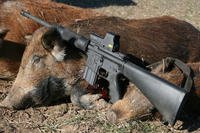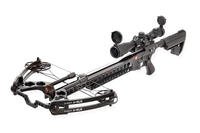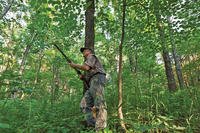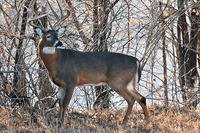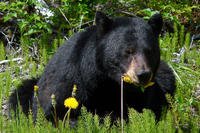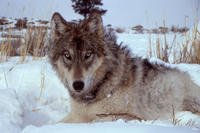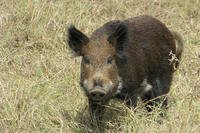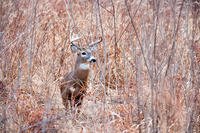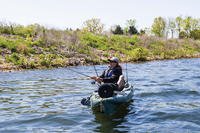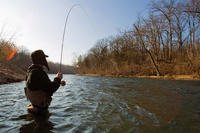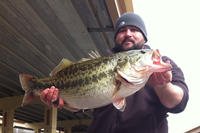Citified coyotes are a close-to-home option for predator hunters across the nation.
by Mark Kayser
Two seasons ago I had a classic encounter with a metro coyote on a Sunday morning. At dawn I used puppy distress calls. The lights of the city were visible in the distant background when a large male coyote trotted into view. He came from the city side and either he hadn't been successful on his suburban hunt or he was just curious to see what was making the racket.
It didn't matter. I let him cruise within 75 yards before I barked at him for a standing shot. My rifle ended his backyard raiding days.
This male coyote came from a favorite ranch of mine where the boundaries are within one mile of city limits. Half the coyote population travels to the rural side of the ranch to hunt a large river drainage, but others use the city side as their hunting grounds. I often sneak in under the cover of darkness to set up in front of coyotes returning from suburbia.
If you're a coyote hunter you might have been riveted by some rather shocking headlines last spring. "Youth Foils Coyote Attack on Boy in New Jersey" and "Second Coyote Attack on Child in New Jersey." These not only should put you on alert when it comes to watching your toddlers as they loiter near the swing set, but such news flashes might also make you want to switch your hunting location closer to home … or at least nearer someone's home.
As coyotes migrate across the country and set up residencies in states where historically they've never set paw, more and more people come into contact with them. Coyotes opportunistically feed on most anything, including garbage. And as they continue to expand their range, they've discovered that suburbs not only provide garbage, but gardens, rodents, poodles, cats and even the occasional plump baby sitting in a backyard.
Residents of Los Angeles, Denver and other Western coyote hideouts have been living with the predators for years, but consider this: A study by wildlife ecologists at Ohio State University studied coyote populations in Chicago for six years and concluded that coyotes have adapted to a suburban lifestyle, even making their homes in the middle of heavily populated communities.
Interestingly, even though these suburban coyotes lived closer to humans, they survived longer than coyotes in rural settings. The findings backed up what Western urbanites living with coyotes already know. Coyotes not only dine on small rodents, and anything else they can find, but also on pets. The most interesting part of the study involved the estimated population of coyote's in the greater Chicago area. Researchers estimated the coyote population at possibly 2,000 animals.
Suburban residents of California, Washington, Oregon, Arizona and other states have shared neighborhoods with coyotes for decades. My parents, who winter in the retirement Mecca of Mesa, Ariz., see coyotes trotting down the streets of their senior citizens' community. Golfers in the area note coyotes on the fairways, and howls emanating from well within the city limits regularly accompany the desert sunset.
Your Private Hunt Club
The abundance of coyotes close to home offers opportunities for hunters. Western coyote hunters have access to millions of acres of public land, but it's often difficult to find huntable land on the East Coast. I have one friend in Pennsylvania who gripes about having only 200 acres to hunt, compared to the 200,000 acres I have at my disposal.
Suburbia provides hunters like him more options, though. Instead of driving miles to call on overhunted public lands, he can focus on small properties on the outskirts of cities, suburbs and developments. So can you. There's also the likelihood of being welcomed with open arms. Hobby farmers who keep goats, sheep and chickens might suddenly find themselves the victim of coyote attacks. The same goes for owners of small acreages who have cats and dogs. As the Ohio study revealed, coyotes routinely dine on small pets.
Coyotes are effective killers and will tackle prey twice their size, but remember, they are wily, too. Predators don't put themselves at risk while trying to procure calories unless it's absolutely necessary. Taking extra risks when tackling prey increases the chances that a predator will be injured, plus it might expend more energy and burn more calories than it stands to gain from a successful pursuit.
Easy Pickin's
All things considered, then, it's a no-brainer that coyotes target pets in suburbia. A recent survey by the American Pet Product Manufacturer's Association concluded there were approximately 164.4 million dogs and cats in America. The survey estimated that there were 73.9 million dogs and 90.5 million cats, mainly living in the suburban shadows of major metropolitan areas.
Those numbers indicate a steady supply of food for hungry, city-dwelling coyotes, but the real reason they target pets is because they have retained their predatory nature, while dogs and cats have lost much of their instinctive caution. Whereas coyotes and other predators have to hunt for a living, pets simply waddle over to a bowl of owner-placed food, fill up, then leave their scent scattered across the backyard.
Predator control officials point to pet-feeding practices as a prime reason coyotes target pets in suburbs. Dog and cat food left outside also lures all sorts of wild animals looking for an easy meal.
City Hideout
If you do decide to target suburban coyotes you'll need a plan. First, research local game laws and firearms regulations. Hunting in the suburbs is more than likely illegal. City and county ordinances might forbid on discharging firearms in close proximity to houses.
Check regulations to determine where you can hunt and what weapons you are allowed to use. Because of the explosion of deer populations in many suburbs shotgun and/or bow-only zones have been established to cull their numbers. This is good news for predator hunters because it usually opens up opportunities to use those same weapons for coyotes.
Next, find where the coyotes are hiding. Oftentimes it's in plain sight. Remember the headlines last year about New York? Who can forget the infamous Hal? In 2006, New York wildlife officials chased Hal for two days. The celebrity coyote called Manhattan's Central Park home, using it for cover while he raided the city for snacks. In early 2007, a coyote slipped into a Quiznos sandwich shop in Chicago, only to be captured in the cooler.
Such cases reflect the opportunistic nature of urban and suburban coyotes. It also demonstrates that they might be hiding in plain sight. I recall one news special that spotlighted metro coyote problems and filmed a coyote walking through a park going unnoticed by the park visitors. One lady out walking her dog even tried to pet it, thinking that it was another dog. Of course, the coyote dodged her attempt, but it was obviously hiding in plain sight.
An animal-damage control official told me that a big reason for coyotes' success in the suburbs is due to the fact they can hide in the small patchwork of cover created by subdivisions and developments. Rough, rugged terrain is often overlooked by developers and left as a green area between homes. Small canyons, briar patches, wetlands and associated tangles provide hiding cover. Coyotes make use of such areas.
Coyotes might stay within city limits, but many don't and these provide the best opportunities for hunters. By contacting landowners of tracts of land surrounding subdivisions and developments, you should be able to pinpoint hunting sites for future setups. Animal-damage control officers overrun with complaints about coyotes might be willing to share a few leads as well. Checking the newspaper headlines frequently is one of the best ways to find metro coyote hunting locations. Stay tuned to television news for stories of coyotes preying on livestock or reports of pets mysteriously disappearing and even stories of coyotes attacking humans. The victims would likely welcome an offer to eliminate their problems with coyotes.
Metro Methods
Setting up for city coyotes takes ingenuity. Whenever you hunt, you have to be able to discharge a firearm or use another legal weapon such as a bow, crossbow, or high-power airgun legally. Once you have that settled, your best options for metro coyotes is either an ambush or a calling setup.
If calls aren't an option, use the ambush route. Coyotes must travel to hunt and to bedding cover. Metro coyotes live in close proximity to humans so their movement is often noted by suburbanites. Through contacting neighbors who have seen coyotes and noted their time of travel and direction of travel, you might be able to ambush the interlopers.
The patchworks of undeveloped tracts between subdivisions are great locations to watch. They provide bedding cover and secure travel corridors. By studying such corridors you can locate vantage points to watch for traveling coyotes, thus providing a sniper-style position for shooting.
If you decide to call, use the same tactics you would in rural settings, but cozy up to subdivisions to target backyard marauders. Since coyotes will be targeting small prey found in the region, there's no reason to deviate from using prey-in-distress calls such as dying rabbits, rodent squeakers, squalling jackrabbits and woodpeckers.
I like to be different, and that's why I mix it up a bit with some backyard food sounds. Hunter's Specialties Prey Master digital caller includes memory cards for some interesting sounds that occur everyday in suburbia and on hobby farms. The sounds of baby birds in distress, pleading chickens, puppies in distress, cat meows, kid-goat-in distress and others mimic the sounds of animals and birds of the suburban menu. FoxPro and others offer such options to fool city savvy coyotes.
